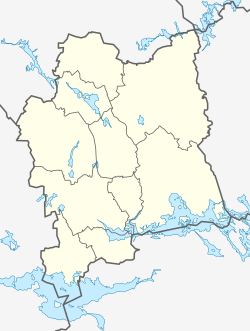Västerås, Sweden
| Västerås | |
|---|---|

Skrapan in Västerås City
|
|
| Nickname(s): Mälarstaden (The City of Mälaren), Gurkstaden (The Cucumber City) | |
| Coordinates: 59°36′58″N 16°33′10″E / 59.61611°N 16.55278°ECoordinates: 59°36′58″N 16°33′10″E / 59.61611°N 16.55278°E | |
| Country | Sweden |
| Province | Västmanland |
| County | Västmanland County |
| Municipality | Västerås Municipality |
| Area | |
| • City | 52.94 km2 (20.44 sq mi) |
| • Metro | 962.78 km2 (371.73 sq mi) |
| Elevation | 17 m (56 ft) |
| Population (150 000) | |
| • City | 151 000 |
| • Density | 2,094/km2 (5,420/sq mi) |
| • Metro | 145,218 (Västerås Municipality) |
| Time zone | CET (UTC+1) |
| • Summer (DST) | CEST (UTC+2) |
| Postal code | 721 00 – 728 20 |
| Area code(s) | (+46) 021 |
| Website | www |
Västerås [vɛstɛrˈoːs] is a city in central Sweden, located on the shore of Lake Mälaren in the province Västmanland, some 100 kilometres (62 miles) west of . The city had a population of 110,877 inhabitants in 2010, out of the municipal total of 150,000 (2017). Västerås is the seat of Västerås Municipality, the capital of Västmanland County and an episcopal see.
Västerås is one of the oldest cities in Sweden and Northern Europe. The name originates from Västra Aros (West Aros), which refers to the river mouth of Svartån. The area has been populated since the Nordic Viking Age, before 1000 AD. In the beginning of the 11th century it was the second largest city in Sweden, and by the 12th century had become the seat of the bishop. Anundshög is located just outside the City of Västerås. Anundshög is Sweden's largest burial mound. "Hög" is derived from the Old Norse word haugr meaning mound or barrow. It was built about 500 AD and is over 74 yards (68 m) wide and is almost 10 yd (9.1 m) high. In the ensuing centuries, a cathedral and a monastery were built. The first City Arms date from the end of the 13th century. King Gustav I of Sweden called together the riksdag in Västerås. During the riksdag assembly, the decision was made to convert Sweden into a Protestant state and to remove the power of the Catholic Church. Rudbeckianska gymnasiet, the oldest gymnasium (secondary school) in Sweden, was built in Västerås by Johannes Rudbeckius in 1623. In the 18th and 19th centuries, the growing of cucumber became popular, and Västerås received the nickname Gurkstaden (the Cucumber City), which it still retains today.
...
Wikipedia


